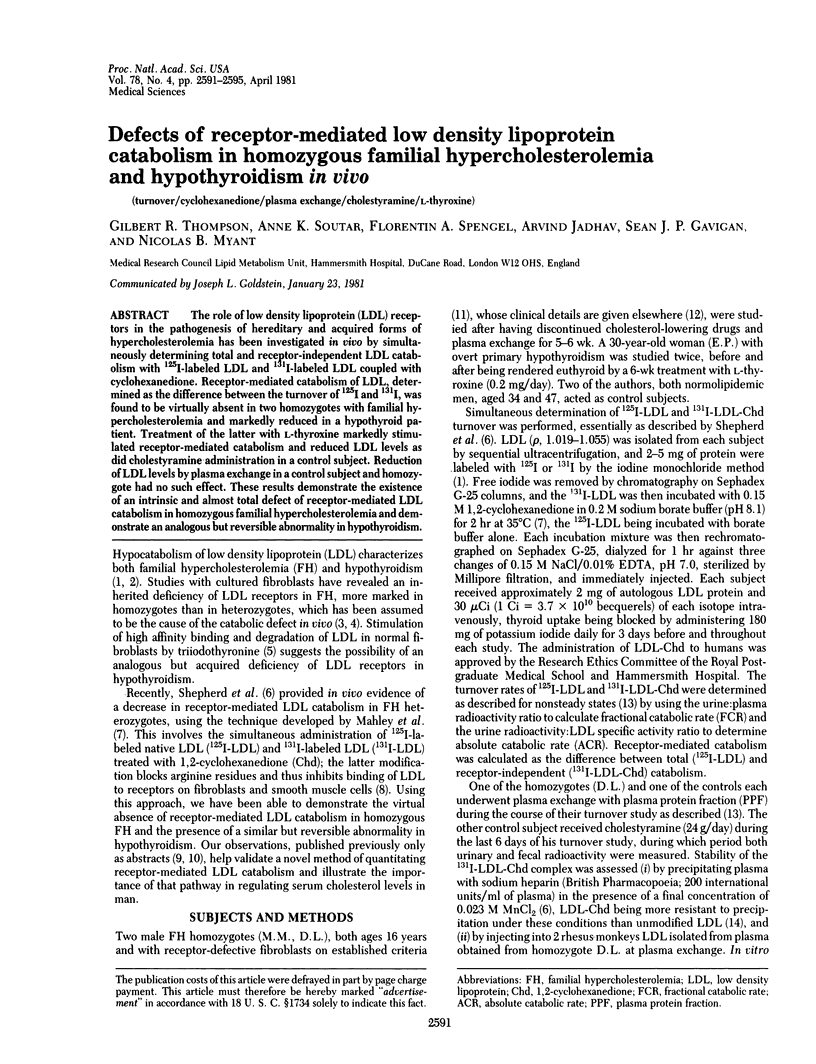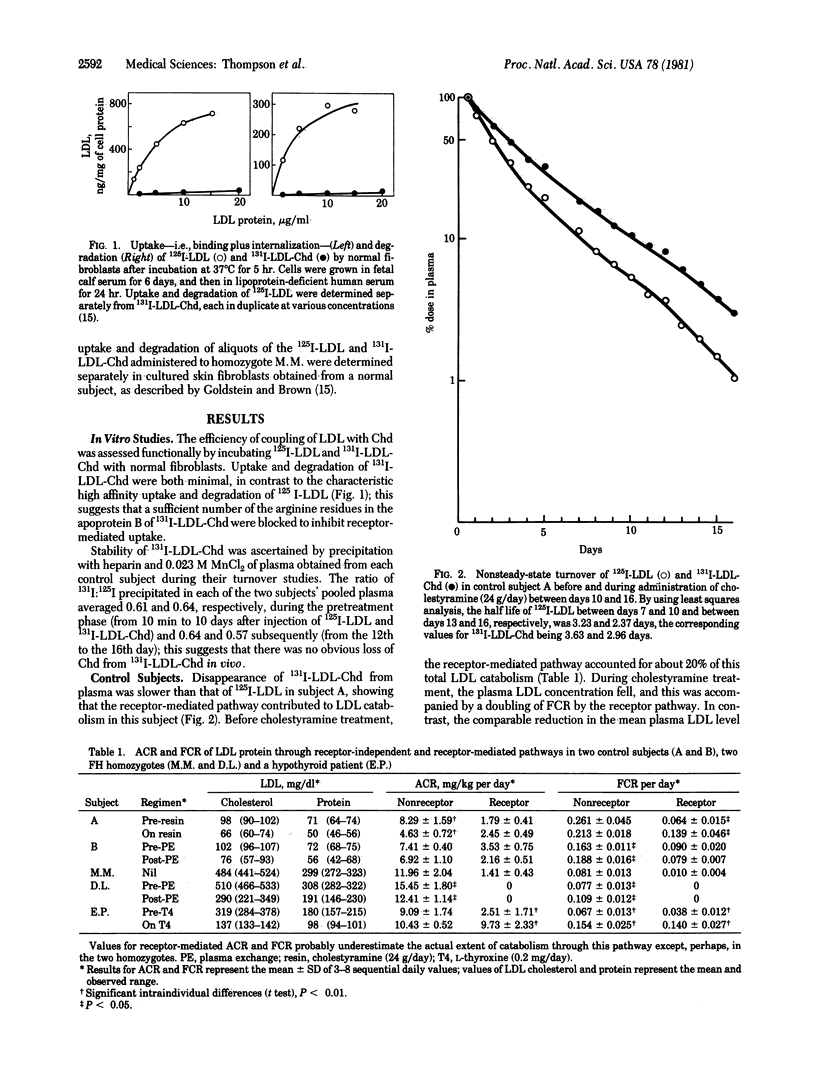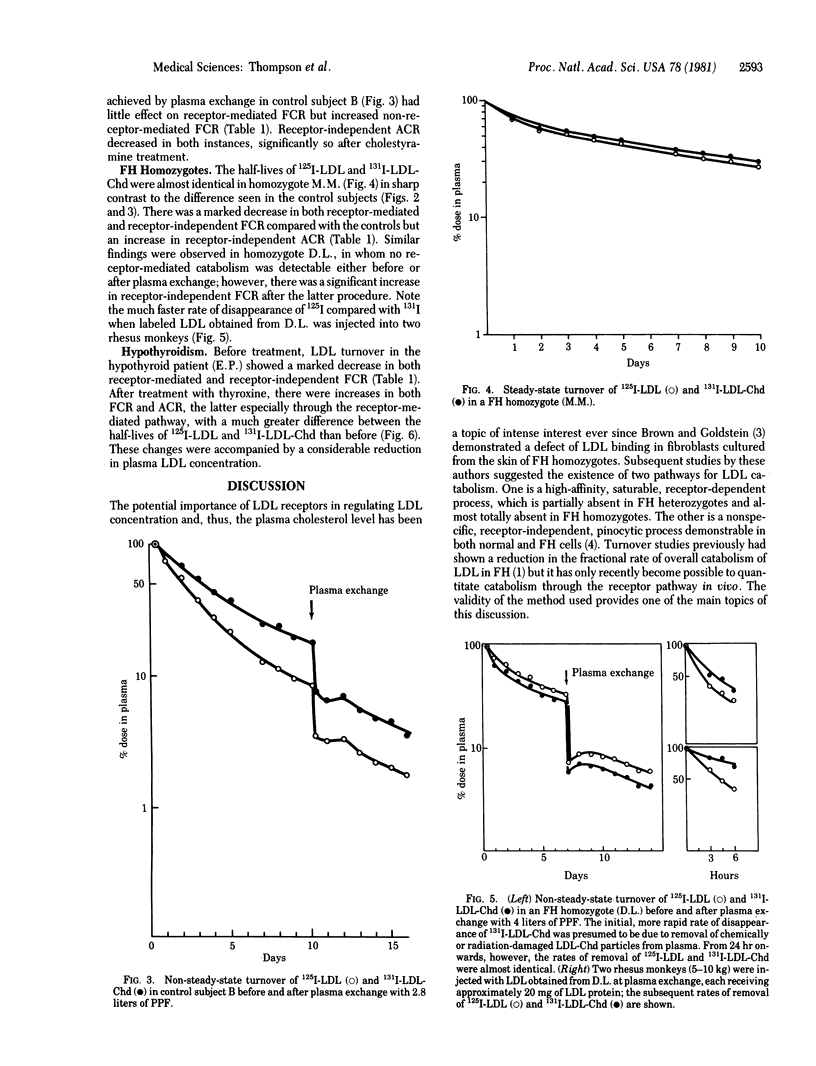Abstract
The role of low density lipoprotein (LDL) receptors in the pathogenesis of hereditary and acquired forms of hypercholesterolemia has been investigated in vivo by simultaneously determining total and receptor-independent LDL catabolism with 125I-labeled LDL and 131I-labeled LDL coupled with cyclohexanedione. Receptor-mediated catabolism of LDL, determined as the difference between the turnover of 125I and 131I, was found to be virtually absent in two homozygotes with familial hypercholesterolemia and markedly reduced in a hypothyroid patient. Treatment of the latter with L-thyroxine markedly stimulated receptor-mediated catabolism and reduced LDL levels as did cholestyramine administration in a control subject. Reduction of LDL levels by plasma exchange in a control subject and homozygote had no such effect. These results demonstrate the existence of an intrinsic and almost total defect of receptor-mediated LDL catabolism in homozygous familial hypercholesterolemia and demontrate an analogous but reversible abnormality in hypothyroidism.
Full text
PDF




Selected References
These references are in PubMed. This may not be the complete list of references from this article.
- Allen J. M., Thompson G. R., Myant N. B., Steiner R., Oakley C. M. Cadiovascular complications of homozygous familial hypercholesterolaemia. Br Heart J. 1980 Oct;44(4):361–368. doi: 10.1136/hrt.44.4.361. [DOI] [PMC free article] [PubMed] [Google Scholar]
- Brown M. S., Goldstein J. L. Familial hypercholesterolemia: defective binding of lipoproteins to cultured fibroblasts associated with impaired regulation of 3-hydroxy-3-methylglutaryl coenzyme A reductase activity. Proc Natl Acad Sci U S A. 1974 Mar;71(3):788–792. doi: 10.1073/pnas.71.3.788. [DOI] [PMC free article] [PubMed] [Google Scholar]
- Chait A., Bierman E. L., Albers J. J. Regulatory role of triiodothyronine in the degradation of low density lipoprotein by cultured human skin fibroblasts. J Clin Endocrinol Metab. 1979 May;48(5):887–889. doi: 10.1210/jcem-48-5-887. [DOI] [PubMed] [Google Scholar]
- Goldstein J. L., Brown M. S. Binding and degradation of low density lipoproteins by cultured human fibroblasts. Comparison of cells from a normal subject and from a patient with homozygous familial hypercholesterolemia. J Biol Chem. 1974 Aug 25;249(16):5153–5162. [PubMed] [Google Scholar]
- Goldstein J. L., Brown M. S. The low-density lipoprotein pathway and its relation to atherosclerosis. Annu Rev Biochem. 1977;46:897–930. doi: 10.1146/annurev.bi.46.070177.004341. [DOI] [PubMed] [Google Scholar]
- Goldstein J. L., Dana S. E., Brunschede G. Y., Brown M. S. Genetic heterogeneity in familial hypercholesterolemia: evidence for two different mutations affecting functions of low-density lipoprotein receptor. Proc Natl Acad Sci U S A. 1975 Mar;72(3):1092–1096. doi: 10.1073/pnas.72.3.1092. [DOI] [PMC free article] [PubMed] [Google Scholar]
- Langer T., Strober W., Levy R. I. The metabolism of low density lipoprotein in familial type II hyperlipoproteinemia. J Clin Invest. 1972 Jun;51(6):1528–1536. doi: 10.1172/JCI106949. [DOI] [PMC free article] [PubMed] [Google Scholar]
- Mahley R. W., Innerarity T. L., Pitas R. E., Weisgraber K. H., Brown J. H., Gross E. Inhibition of lipoprotein binding to cell surface receptors of fibroblasts following selective modification of arginyl residues in arginine-rich and B apoproteins. J Biol Chem. 1977 Oct 25;252(20):7279–7287. [PubMed] [Google Scholar]
- Mahley R. W., Innerarity T. L. Properties of lipoproteins responsible for high affinity binding to cell surface receptors of fibroblasts and smooth muscle cells. Adv Exp Med Biol. 1978;109:99–127. doi: 10.1007/978-1-4684-0967-3_6. [DOI] [PubMed] [Google Scholar]
- Mahley R. W., Weisgraber K. H., Innerarity T. L. Interaction of plasma lipoproteins containing apolipoproteins B and E with heparin and cell surface receptors. Biochim Biophys Acta. 1979 Oct 26;575(1):81–91. doi: 10.1016/0005-2760(79)90133-4. [DOI] [PubMed] [Google Scholar]
- Mahley R. W., Weisgraber K. H., Melchior G. W., Innerarity T. L., Holcombe K. S. Inhibition of receptor-mediated clearance of lysine and arginine-modified lipoproteins from the plasma of rats and monkeys. Proc Natl Acad Sci U S A. 1980 Jan;77(1):225–229. doi: 10.1073/pnas.77.1.225. [DOI] [PMC free article] [PubMed] [Google Scholar]
- Patthy L., Smith E. L. Reversible modification of arginine residues. Application to sequence studies by restriction of tryptic hydrolysis to lysine residues. J Biol Chem. 1975 Jan 25;250(2):557–564. [PubMed] [Google Scholar]
- Shepherd J., Bicker S., Lorimer A. R., Packard C. J. Receptor-mediated low density lipoprotein catabolism in man. J Lipid Res. 1979 Nov;20(8):999–1006. [PubMed] [Google Scholar]
- Shepherd J., Packard C. J., Bicker S., Lawrie T. D., Morgan H. G. Cholestyramine promotes receptor-mediated low-density-lipoprotein catabolism. N Engl J Med. 1980 May 29;302(22):1219–1222. doi: 10.1056/NEJM198005293022202. [DOI] [PubMed] [Google Scholar]
- Thompson G. R., Spinks T., Ranicar A., Myant N. B. Non-stedy-state studies of low-density-liproprotein turnover in familial hypercholesterolaemia. Clin Sci Mol Med. 1977 Apr;52(4):361–369. doi: 10.1042/cs0520361. [DOI] [PubMed] [Google Scholar]
- Walton K. W., Scott P. J., Dykes P. W., Davies J. W. The significance of alterations in serum lipids in thyroid dysfunction. II. Alterations of the metabolism and turnover of 131-I-low-density lipoproteins in hypothyroidism and thyrotoxicosis. Clin Sci. 1965 Oct;29(2):217–238. [PubMed] [Google Scholar]


